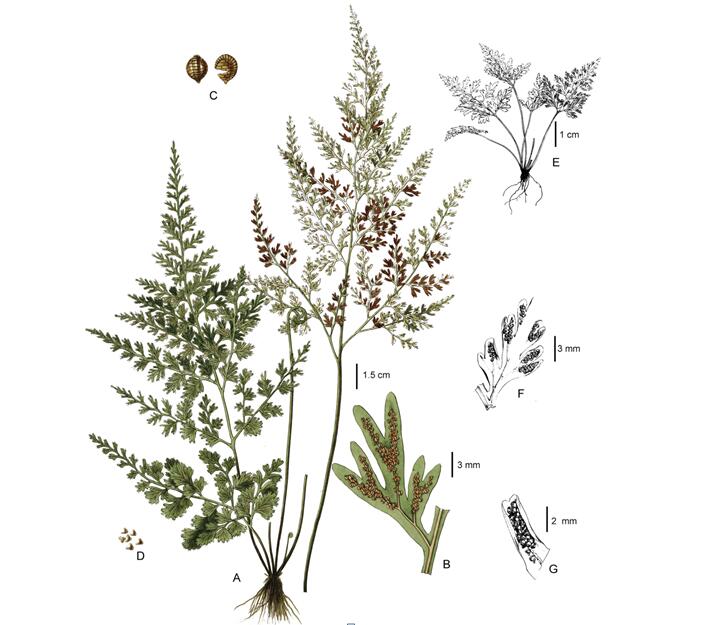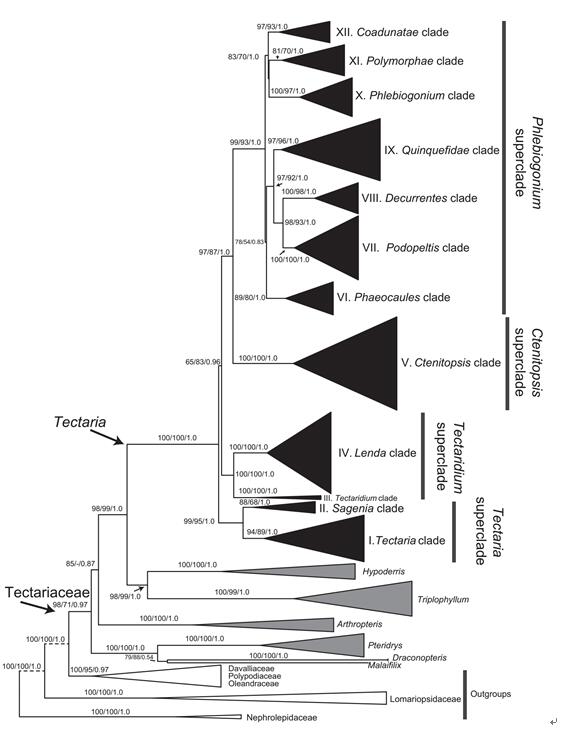The evolution of ferns has resulted in some quite diversified groups, for more than two hundred years, taxonomists have aimed at recognizing natural groups in ferns at different taxonomic levels. The advent of phylogenetic analysis based on molecular sequence information has radically revolutionized our understanding of fern evolution.
The relationships among most fern groups have been tested based on molecular evidences. However, the evolutions histories of some large fern groups (e.g. Pteris, Tectaria) have still been poorly studied. Recently, researchers reconstructed the global phylogenies of the subfamily Pteridoideae, the genus Tectaria and Pyrrosia. There are some mainly achievements of the studies.
The subfamily Pteridoideae is one of the five subfamilies often recognized in Pteridaceae. Among the abundant species are some most useful ferns in the subfamily Pteridoideae, such as the ‘‘king of the gold ferns”, i.e., Pityrogramma chrysophylla and the first identified arsenic hyperaccumulator in ferns, Pteris vittata.
In this study, the researchers used molecular data from six plastid loci of 154 accessions representing ca. 87 species in 14 genera of Pteridaceae subfam. Pteridoideae and related groups to infer a phylogeny. The results show that Pteridoideae is monophyletic and the newly defined subfamily is composed of 14 genera including a newly described genus Gastoniella Li Bing Zhang & Liang Zhang (Figure 1).

Figure 1. Illustration of Gastoniella. A–D. Gastoniella chaerophylla: —A. Habit. —B. Portion of pinna rachis with pinna. —C. Sporangia. —D. Spores. E–G. Gastoniella ascensionis. —E. Habit. —F. Portion of pinna rachis with pinna. —G. Portion of ultimate segment (A & D reproduced and modified from Hooker and Greville (1831); E & G reproduced and modified from Hooker (1854). (Image by KIB)
Tectaria (Tectariaceae) is one of the most confusing fern genera in terms of its circumscription and phylogeny. Since its original description, a number of genera had been moved into or related with this genus while others had been segregated from it.
According to the analyses of data from eight plastid and one nuclear marker of 360 accessions, our major results indicated that: the most recently proposed circumscription of Tectaria is strongly supported as monophyletic; 12 well-supported major clades in Tectaria are revealed, differing from one another in molecular, morphological, and geographical features (figure 2); evolution of 13 morphological characters is inferred in a phylogenetic context and morphological synapomorphies of various clades are identified; and in particular; free venation in Tectaria is inferred to be repeatedly derived from anastomosing venation, an evolutionary phenomenon not documented previously in vascular plants in a phylogenetic context based on both plastid and nuclear evidence.

Figure 2. Simplified maximum likelihood phylogeny of Tectaria and related taxa based on eight plastid markers (Image by KIB)
The Old World fern genus Pyrrosia (Polypodiaceae) is a morphologically highly simplified genus in the fern family Polypodiaceae containing 51–100 species (Figure 3). After analyses of DNA sequences of five plastid markers of 220 accessions.
The major conclusions include: Pyrrosia as currently circumscribed is paraphyletic in relation to Platycerium and can be divided into two genera: Pyrrosia s.s. and Hovenkampia (gen. nov.), with Hovenkampia and Platycerium forming a strongly supported clade sister to Pyrrosia s.s.; Subfamily Platycerioideae should contain three genera only, Hovenkampia, Platycerium, and Pyrrosia s.s.; Four major clades in the genus are identified and three of the four are further resolved into four, four, and six subclades, respectively; The evolution of ten major morphological characters in the subfamily is inferred based on the phylogeny and various morphological synapomorphies for various clades and subclades are identified.

Figure 3. Morphology of Pyrrosia. A–E. The Neoniphopsis clade. F–O. The Niphobolus clade. Photo credit: A–E & M–N, R. Knapp; F & G, L. Zhang; H–J & O–P, C. -W. Chen; K & L, D. L. Nickrent, M. Costea, J. F. Barcelona, P. B. Pelser, and K. Nixon. (Image by KIB)
The research teams include a group led by Dr. SUN Hang from the Kunming Institute of Botany, Chinese Academy of Sciences (KIB/CAS), a group led by Prof. GAO Xinfen from the Chengdu Institute of Biology (CIB), and a group led by ZHANG Libing from Missouri Botanical Garden (MO).
The studies were supported by the National Science Foundation of China, a grant from the Foundation Franklinia to the Flora of China project, and the Glory Light International Fellowship for Chinese Botanists at Missouri Botanical Garden.
The three studies were separately published in Molecular Phylogenetics and Evolution:
Contact:
Key Laboratory for Plant Diversity and Biogeography of East Asia, CAS
Kunming Institute of Botany, CAS
Dr. ZHANG Liang
Email: zhangliang@mail.kib.ac.cn
(Editor:YANG Mei)




